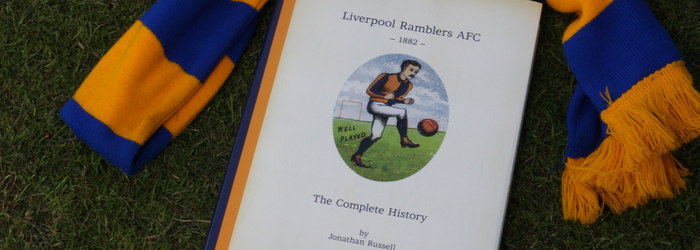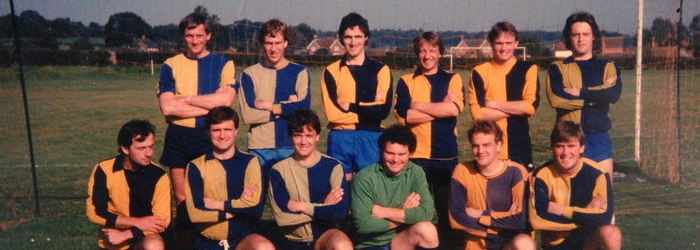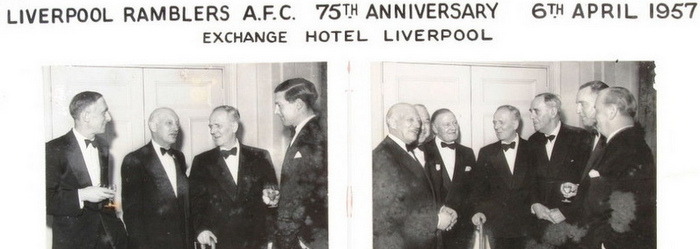» The Birth of The Liverpool Ramblers.
The local public school players, during the autumn of 1881, slowly began to gather their numbers together and practice as a team. The old boys of Eton and Harrow, by far the most numerous amongst them, were soon in the news. The following report, dated 14th, January 1882, appeared in a publication that was called “The Field”. It was a tabloid that was printed for the benefit of sporting Gentleman and it was published, nationally, once a week.
ETON v HARROW, (LIVERPOOL)
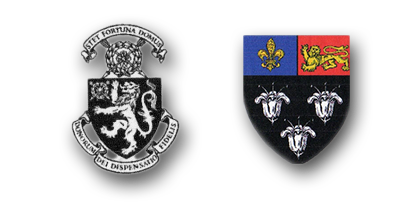
A match was played on Saturday under Association rules at Allerton Tower near Liverpool, between teams of past and present members of these schools. The weather fortunately proved fine, and the advantage of the fall of the ground was more than balanced by a strong breeze blowing up the hill. At first the game was very even, Harrow having the wind with them, and both goals were several times threatened before, by a good pass from a half back, E Baxter managed to score for Eton. Which performance his brother repeated shortly before the ends were changed. After half time, with the wind at their backs, Eton kept the ball chiefly in their opponents ground, but the Harrovians showed better form than in the first, and several good corners kicks were made. Eton, only succeeding in adding one goal to their total, winnings when time was called, by 3 goals to 0. For the winners the brothers Baxter, Earle and J Gladstone were conspicuous, while for Harrow J F Bateson, and H Stewart Brown did their best to avoid defeat.
Eton: - E. V. Rayner (goal), J. S. Gladstone and R. Bickersteth, A. S. Gladstone and R. Pilkington, E. Baxter, H. A. Graves, W. E. Earle, E. Bateson O. Rayner and J. Baxter
Harrow: - E. Crossley (goal), Brockenhurst and J. F. Bateson, E. Stewart-Brown and A. Alexander, H. Rawcliffe, H. Bushell, R. Brockenhurst, H. Stewart-Brown and P. Bateson.
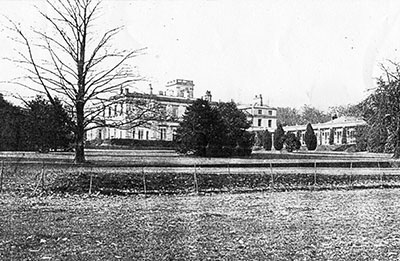
It is likely that the above-mentioned game took place during a time when the players, who were still attending college, were to be at home with their families during the Christmas holiday. What is known for certain is that the venue, Allerton Tower, was the residence of a wealthy Liverpool businessman named Sir Thomas Earle. His son William Edward Earle is listed amongst the players on the Eton team. Also on the field was Percy Bateson.
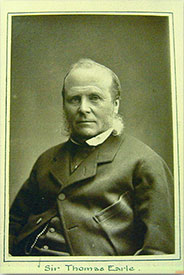
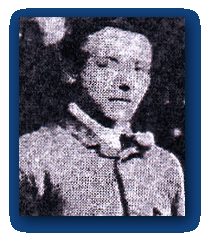
Percy Bateson was born at West Derby in 1862.and was the second of five sons born to Liverpool cotton broker, John Bateson. He proved to be a rational individual whose discernment and ingenuity was to have lasting effect on the development of association football in his native Liverpool. His brothers, James and Wilfred, also played football for Liverpool Ramblers. Their Mother was Margaret Maine the daughter of Nicholls Maine of Ballymena County Antrim and the family eventually settled at Emsworth, Wavertree. In January 1876 Percy enrolled at Harrow School and remained there until the summer of 1877. He then entered Edinburgh University where he became conversant with the rules of association football. In 1880 he came home to Liverpool and took up employment within the family business. Percy Bateson, back amongst his own people, continued to pursue an active sporting life and, along with E & J Baxter and G W Turner, he was soon to turn out in the colours of Bootle AFC against their local rivals, Everton.
The match was played before a crowd of five hundred people on the new Bootle ground at Marsh Lane. The fixture was an innovation and gave the public school players a brief glimpse of how the game would be played in the future. Everton, to aid their development, were importing experienced players from Scotland. Nevertheless E Baxter, when play got under way, gave Bootle an early lead. Jack McGill however, dominated the rest of the game. The Scotsman, who was signed from Glasgow Rangers, gave a great solo display. He scored twice in each half as Everton ran out winners by 4 goals to 1.
Percy Bateson, by means of a dispatch, now called all public school players, who were, at the time, resident in the Merseyside area, to a meeting that was to be held in Liverpool. This letter, which may be seen to-day in The Ramblers clubhouse, was worded as follows. … “ It is felt that want has been growing for some time for a first class association football Club in Liverpool. With this object in view a Committee has been formed and intending members are requested to send their names to any one of the committee, as soon as possible. A meeting of the Committee will be held of Friday 24th February 1882. A general meeting will then be held of all the members at which election of officers, selection of ground and other preliminaries will be proceeded with. The club will not begin actively until next season but it is thought advisable to procure the names of members now in order to make the arrangements quite complete so that there will be no hitch when the season commences. Your assistance & co-operation are earnestly solicited.
Percy Bateson speaks of the need for a first class association football club in his native Liverpool, which he clearly feels, is trailing behind certain other areas of England. He had played several matches for Bootle, against various levels of opposition, and was well qualified to appraise the situation. Birmingham, Nottingham and Sheffield had, in 1882, a thriving football community, as did the mill towns of east Lancashire. Two of the leading clubs, Blackburn Rovers and Sheffield Wednesday, had just recently meet each other, at Huddersfield, in the first ever FA Cup semi-final to be played outside of London. Percy Bateson, in the meantime, called a general meeting at the offices of his Uncle Mr. James Bateson, in Old Hall Street, Liverpool. The interested parties, as they assembled, would have possibly spoke of the many developments that were taking place in Liverpool at the time.
The highlight of the year was the local parliamentary bye-election. Liverpool, with 62,039 registered electors, sent, in 1882, three members to Westminster. The bye-election was won by Samuel Smith (Liberal) who defeated Arthur Bower Forwood (Conservative) by the margin of 309 votes. Liverpool University, situated on Brownlow Hill, had recently opened with an intake of 45 students and the foundations of the new County Session House were being laid on William Brown Street. The Port of Liverpool was extending along the banks of the River Mersey. The Alexandria, Harrington and Langton Docks had recently been opened and the Hornby Dock was under construction. Waterloo Rugby Club had just been founded and the England cricket team was making the initial Ashes tour of Australia.
Percy Bateson called the meeting to order and addressed an audience that contained the representatives from many of the leading commercial families of Liverpool. They included: E. Baxter, W. E. Earle, A.B.Hull, R. V. Pilkington, E. V. Rayner, and G. W. Turner. The club officers were elected as follows: President, Sir Thomas Earle, Bart, Vice-Presidents, J. Bateson, S. H. Brown, H.H. Hornby, J. E. Moss, E. V. Rayner and William. Pilkington. Percy Bateson was elected as club Secretary. E Baxter was elected as club captain and was to serve on the committee along with: F. Bushall, W. E. Earle, J. Heald, A. B. Hull, and R. M. Pilkington. Mr. E. V. Rayner, it was decided, would become club Treasurer but A. S. Gladstone would occupy the position, for the moment. The proceeding were, many years later, recounted in two articles that appeared in the “ Liverpool Football Echo”.
Wilf Blazard was a journalist who wrote under the pen name of “ Blackstaff “ and it was he who researched and penned both articles. They were later made in to a booklet and reprinted, in 1923, under the title “ History of the Liverpool Ramblers amateur Football Club“. G. W Turner, who was present at the inaugural meeting, gave his kind assistance as did Wilfred Bateson the younger brother of Percy. They confirmed that the club uniform, orange and dark blue quartered shirts, were, at that time, the colours of one the houses at Eton College.” Not very pretty, remarked Wilf Bateson, “ but very distinctive “. The Old Etonians may have also influenced in the decision to add a suffix to name their native town as Eton Ramblers is the title of the Old Etonian cricket team. Liverpool Ramblers AFC was now ready to challenge the leading football clubs in England. Change however, was beginning to affect the land.
Blackburn Rovers had that very year, become the first team from the North of England to reach the FA Cup final. The trophy had until then, been considered the sole property of the gentleman amateur players from the South. The teams from the North of England, aided by imported professionals, were beginning to threaten this established order. The Old Etonians, in one last gesture of defiance, had beaten the aspirants 1-0 to lift the trophy at Kennington Oval. They were nevertheless, the last amateur team to do so.
Liverpool, unlike many other major towns, had yet to place a team in the competition. Percy Bateson, in order to remedy the matter, registered Liverpool Ramblers with the F.A. and entered his side for the tournament. He also registered his team with Lancashire F.A. thus making them eligible to enter the county knock out competition. Liverpool Ramblers, in order to fulfill these fixtures, now needed to find a suitable ground. This was, in 1882, no simple task.
Percy Bateson, ever vigilant, had taken note of the new pavilion that was rapidly taking shape on the Southern outskirts of Liverpool. The location, situated on Aigburth Road, was to be the new home of Liverpool Cricket Club. He approached those in charge and requested permission for The Ramblers to play their matches on the large playing field. The cricket committee, with some reluctance, refused the request. They were at the time, having problems with the newly laid playing surface that was taking its time to bed down. A solution however, lay close at hand.
Percy Bateson now approached the management of the Aigburth Hotel. The hostelry, which lay adjacent to the cricket ground, had at its disposal, a large field that could be utilized for recreational purposes. The meadow, which lay behind the Inn, was formerly part of the nearby Aigburth Hall estate. It was ideal for football and could by easily reached by railway train, from the centre of Liverpool. Percy Bateson now began to re-think his strategy. He once again approached the cricket committee who agreed, for a nominal fee, to allow the football players to use the club pavilion in order to change. Liverpool Ramblers had found their first home.
Percy Bateson, by good fortune, had chosen the perfect moment to integrate his Liverpool Ramblers in to the Merseyside football scene. The local football clubs, around ten in number, were at the time, attempting to form their own football association similar to the ones already in existence at Sheffield and Birmingham. The first meeting, which took place at the Tarleton Hotel, Liverpool, was well attended and proved a great success. Liverpool Ramblers, although not represented on the night, became one of the founder members of the Liverpool & District Football Association. They were also included in the draw for a new knock out competition that was to be called the Liverpool Cup. (To day, along with Everton, Liverpool Ramblers are the only consistent survivors from the original members.)
Percy Bateson had, in the meantime, been busy arranging a set of fixtures that would keep Liverpool Ramblers entertained during the forthcoming winter months. The club, as September approached, released the following list of fixtures that were to be played by the first X1.
-
September
- 23rd - Bootle.
- 30th - Club Match October
- 7th - Southport (F.A. Cup)
- 14th - Great Marton (Lancashire Cup)
- 21st - St Mary's, Kirkdale
- 28th - Nottingham County November
- 4th - Everton 2nd XI
- 11th - Blackburn Rovers 2nd X1
- 18th - Old Kings Scholars S. R. C., Chester
- 25th - Rossall School. December
- 2nd
- 9th - Shrewsbury School
- 16th - Everton
- 20th - Cambridge University Wanderers
- 23rd - Burscough
- 30th - Wirral Association January
- 6th - Halliwell Jubilee
- 13th - Harrovians v Etonians
- 20th - Toxteth Wanderers (Liverpool Cup)
- 27th - Stanley February
- 10th - Old Kings Scholars S. R. C., Chester March
- 10th - Nottingham County
- 24th - Shrewsbury School
Liverpool Ramblers, for leadership in their inaugural match, engaged the services of an English International player. Henry Cursham, a former pupil at Repton School, had gained extensive experience playing football in his native Nottingham. He was strong running forward player and a prolific goal scorer. This famous player, on his arrival, was quickly introduced to the disorganised state of football on Merseyside.
The Ramblers party, arriving at Marsh Lane, where disappointed to discover that the home club had lost the use of their previous ground thus putting the match in jeopardy. Percy Bateson, along with the Bootle secretary, acted positively. They approached a neighbouring football club, Bootle Wanderers, who allowed the match to be played on their home ground at nearby Sandfield Place. It was here that the two sides eventually, took to the field. The Ramblers line up was as follows, J. Jacob, goalkeeper: R. M. Pilkington and P. C Morris, full backs: J. Heald and G. W. Turner, half backs: H. A. Cursham, E. Baxter, H. Baxter, J. F. Bateson, G. Smith, and T. Williamson, forwards.
---INSERT VENURE FIRST MATCH MAP---The home side quickly exploited the uncertainty of The Ramblers early play and they took a 1-0 lead before the break. The Ramblers, as the game progressed, began to press their opponents and, with minutes remaining, scored what they believed to be a perfectly good goal. The home side however, objected to the goal and claimed it had been scored from an offside position. As no referee had been appointed, the final outcome could not be decided upon and the match ended in confusion. What Harry Cursham must have thought of the proceedings is open to conjecture but he must have been left in no-doubt that Liverpool, in terms of football, lagged far behind his native Nottingham. The Ramblers however, pressed on regardless and became the first club from Liverpool to enter the national F.A. Cup knock out competition.
The Football Association, on accepting their application, placed Liverpool Ramblers in the draw along with the other teams who made up the Northern division. The group included such sides as Bolton Wanderers and Blackburn Rovers. The Liverpool side, which managed to avoid these powerful clubs, was drawn to play away against a side playing under the name of Southport Central. The Ramblers, after arriving in the seaside town, were taken to change at the Shakespeare Hotel before making the short walk to the athletic stadium at Sussex Road. It was here that the match took place. It was watched by a crowd of around three hundred people many of who were reported to be “Fashionable Ladies”. The sides took to field and play commenced.
The home side, which made most of the early running, took a deserved lead mid way through the half. Southport continued to have the better of play until, The Ramblers, thanks to a spectacular goal drew level. Harold Baxter, picking up the ball deep in his own half, went on brilliant solo run. He ran the full length of the field before, with a well-directed shot; he put the Liverpool side level at the break.
The Ramblers, during the recess, made a tactical switch by introducing Percy Bateson in to the forward line. Louis Hornby, who replaced him between the posts, gave an outstanding display. He produced two excellent saves to earn his side a 1-1 draw. Liverpool Ramblers began the game as follows: P. Bateson, G. W. Turner, J. Keyworth, R. M. Pilkington, J. Heald, E. Baxter, H. Baxter, W.E. Earle, R. P. Wilson, W. Platt, and L. C. Hornby.
The replay, which took place the following Saturday, was covered by a local newspaper reporter who left us with this account of a game. … The tie for the English Association Cup was played at Aigburth on Saturday. The ground however being heavy militated somewhat against brilliant play. For the Ramblers, Baxter kicked off, the wind against him, and play was confined for some time to centre of the field, but Coleman by a nice run passed to Rylance, who was cleverly stopped by Baxter, the latter taking the ball up to the Southport 25, a shot at goal being safely warded of by Burnett. The Ramblers soon after obtained a corner, Heald making a good shot, but the Southport forwards rushed the ball down to the Liverpool’s 25, and a splashing scrimmage ensued in a regular quagmire, F G Heaton clearing the Ramblers quarters. Soon after, in consequence of a foul, Southport had a free kick unpleasantly near the home goal, but the sphere went over the bar. The subsequent play up to half time was slightly in favour of Liverpool but no point was scored. On resuming, the Ramblers forwards, by a nice sweep, threatened the visitor’s territory and obtained a corner, but nothing resulting, Rylance sped away, but was cleverly halted by Gladstone, who passed to Heald, who in turn centred to Baxter and the ball was turned over the line. The corner kick was well headed out, but almost immediately another corner fell to Liverpool, and the ball, being well thrown in the goal, was kicked by Baxter from a bully in front of the visitor’s posts. Yet another corner fell to Liverpool, and after threatening the Southport goal, the leather was sent off the line to the left of the goal. On kicking out, A Dalby took the ball away and passed to Rylance, who, with Coleman’s assistance, pressed the Ramblers quarters. Baxter however, relieved and, after a throw in by Southport, the Ramblers worked down field, but Coleman and Rylance getting possession and working well together were quickly within the Ramblers 25, and a shot at goal was unsuccessful. After the kick out the Ramblers worked with a will and were quickly scrimmaging the ball in front of the Southport posts, Earle putting it through. Again was danger threatened, as the Ramblers, being busy again within the Southport 25, and, by a well directed shot, Baxter again scored: almost immediately after from a corner a fourth goal was kicked by J F Bateson. Southport being defeated at the call of time by four goals to nil. Liverpool Daily Post, 4th, November 1882.
The delight experienced in the national trophy was followed by disappointment in the Lancashire knock out. Liverpool Ramblers, drawn away against Great Marton of Blackpool, could not, owing to the pressures of commerce, contest the match. Percy Bateson, with great disinclination, was forced to send the following telegram.
“I exceedingly regret that this morning I was obliged to send you a telegram saying that we could not get a team to go so far away and therefore must scratch in your favour. Most of our players, being in offices here, are unable to get away at such a time as 12:25 pm and there being no later train that would that suit. I am sorry if you have gone to any great expense, but to recompense that you have won (practically speaking) your first tie. Of course you will inform the association that we have scratched to you”.
Liverpool Ramblers, in a bold gesture, now accepted an invitation to travel and play Nottingham County. They were however, in order to field a reasonable team, forced to enlist the services of certain club members who were not, at the time, resident in the Liverpool area. Football games, played under the association rules, were commonplace in the lace-producing town and unlike games in Liverpool; they were attracting a large crowd of spectators. Harry Cursham, along with other international players, was present in the Nottingham County line up.
The match was played on the Meadow Ground, Nottingham and it was watched by a crowd over 2,500 people who frequently encroached on to the playing field. The home side, as expected soon began to assail the Liverpool goal and Harry Chursham, with an unstoppable shot put the home side one goal to good. The Nottingham man was a constant danger to his former teammates and put the home side 2-0 up at the brake. The home side dominated through out the second half and The Ramblers were glad of some excellent goal keeping from Heald. A goal from Baxter gave the Liverpool side a brief respite before A. W. Chursham sealed the victory for the home side. The game thus ended, Nottingham County 3, Liverpool Ramblers 1.
Notts Club: - H. Jessop (goal), H. Moore and A.T. Dobson (backs), C.T. Dobson, H. Chapman and S. McCrae (half backs) A.W. Cursham and S. G. Smith (right wing), W. Gunn and E.H Greenhaigh (right wing), H.A. Cursham (centre).
Liverpool Ramblers: - J. Heald (goal) J. H. Scott and J.R. Orford, (backs), P. Bateson, G. W. Turner and A. R. Midwood, (half backs), G. S. Sherrington and W. S. Sherrington, (right wing), E.V. Rayner and W.E. Earle, (left wing), E. Baxter (centre).
Nottingham Evening Post, 30th, October 1882
